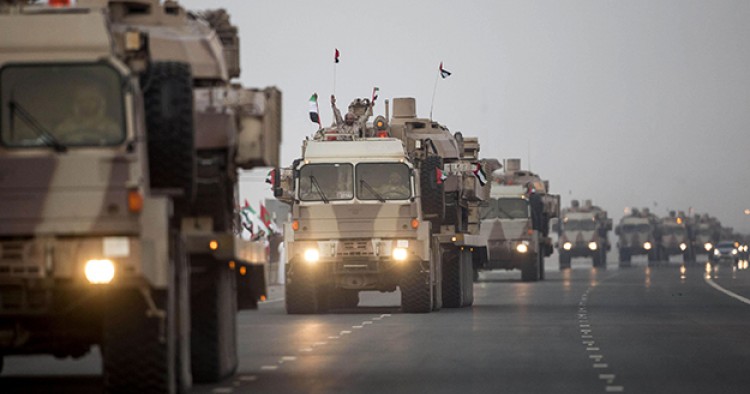The war in Yemen is reshaping the armed forces of Arab Gulf states. It is the first time that Emirati and Saudi elite units are leading a war effort in their bid to counter Yemeni Houthi rebels and forces loyal to former President Ali Abdullah Saleh, as well as a counterterrorism campaign against jihadi groups, mainly Al-Qaeda in the Arabian Peninsula (AQAP).
Due to their intervention in Yemen, Abu Dhabi and, to a lesser extent, Riyadh, are turning from “praetorian” regime security-oriented armies to professional forces with foreign projection capabilities and a national-militaristic rhetoric. This represents a true paradigm shift for the Emirati and Saudi militaries and supports their post-2011 proactive regional policy. The military forces of the Gulf monarchies are also reversing the traditional pattern of Arab military cooperation with Western states, which has been mostly in support of Western-led operations, such as in Afghanistan, Libya, and more recently in Syria and Iraq. Though they still receive logistical and military support from traditional allies such as the United States and the United Kingdom in Yemen, Riyadh now leads and organizes the air force campaign, mostly in the north, while Abu Dhabi does the same for ground operations in the south.
The Saudi and Emirati intervention in Yemen has triggered military reform at a strategic level, in both capabilities and in civil-military relations. The U.A.E. is certainly the vanguard force, as Emirati soldiers directly train Yemen’s tribal forces. From a strategic point of view, Abu Dhabi and Riyadh have started to invest not only in expensive and sophisticated weapons, but also in local expertise, training, arms maintenance, and an indigenous defense industry. This emphasizes long-term goals, fostering the creation of military-centered national strategies, with an impact on foreign policy postures. In this sense, the Emiratis are an inspiring model for Saudi Arabia.
In terms of military capabilities, the Yemeni campaign has tested Saudi and Emirati maritime skills: they enforced the blockade to prevent Houthi insurgent arms smuggling. The U.A.E. navy was able to carry out its first amphibious operation, recapturing Aden and strategic Red Sea islands, Perim, and then al-Mokha. The establishment of military bases abroad—Saudi Arabia in Djibouti, the U.A.E. in Eritrea and Somaliland—suggests that both will seek the development of naval blue water capabilities. Looking at the air campaign, the G.C.C. air forces have frequently performed dynamic targeting instead of fixed ones, showing persisting limits in accuracy, as demonstrated by the high number of civilian casualties.
Since 2016, the Emirati Presidential Guard’s Special Forces have been leading ground counterterrorism operations against AQAP’s fiefdoms in southern Yemen. Although Abu Dhabi already had counterinsurgency experience from Afghanistan, this engagement is unprecedented. In 2016, the U.A.E. military managed to clear some of Aden’s districts and retake Mukalla in Hadhramaut from jihadists, without confronting AQAP directly. Since August 2017, they have been helping Yemeni militias push jihadists out of the Shabwa region, protecting critical oil and gas infrastructures.
Yemen’s war has also deeply influenced civil-military relations in the U.A.E. and Saudi Arabia. Thanks to the first-ever “out of boundaries” ground intervention, Emirati and Saudi militaries are interacting more with their societies, and citizens are coming to identify more fervently with their armed forces. Moreover, the U.A.E. and Qatar introduced conscription in 2014, as did Kuwait in 2017, as a tool of nation-building. In Saudi Arabia, this military service debate is no longer a taboo and the Saudi Grand Mufti openly supports its adoption. The U.A.E. leadership’s narrative, strongly conveyed by the media, depicts the military as a national identity-builder, and thus helps to corroborate the Gulf monarchies’ military paradigm change.
Gulf armed forces are gradually leaving the traditional, regime security-oriented model, to embrace a bolder military pattern, combining foreign projection and national mobilization. The complex intervention in Yemen is their watershed. In the long-term, this transition will likely have political implications, especially for Saudi Arabia. Weakened coup-proofing strategies and rising military cohesion will shape a military officers class, made up of nationals who fought together abroad.
From a regional policy perspective, the interventionist posture may become the “new normal” for Saudi Arabia and the U.A.E., since they are also aware of America’s retrenchment trend in the Middle East. Gulf monarchies are increasingly signing security agreements with Western and Asian partners to enhance national defense capabilities, focusing on training and military-to-military cooperation (as Saudi Arabia recently did with Indonesia, Malaysia, Germany, and the U.A.E. with South Korea and India).
The paradigm shift of Saudi and Emirati militaries aims to preserve the security of the Arabian Peninsula, protecting also smaller neighbors, such as Bahrain and Kuwait, from internal and external threats. The Arab Gulf states share growing security responsibilities in a highly unstable region, as testified by the complex intervention in Yemen. The reshaping of their militaries is part of this new, long-term national mindset.
The Middle East Institute (MEI) is an independent, non-partisan, non-for-profit, educational organization. It does not engage in advocacy and its scholars’ opinions are their own. MEI welcomes financial donations, but retains sole editorial control over its work and its publications reflect only the authors’ views. For a listing of MEI donors, please click here.












